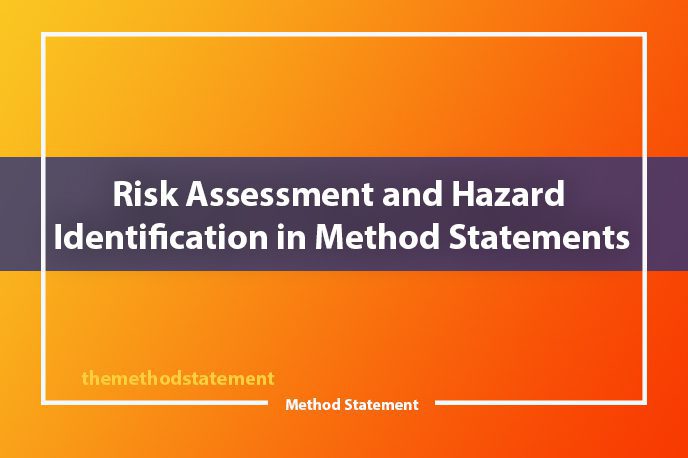Table of Contents
When working on a construction site or any workplace with hazardous activities, it is crucial to prioritize safety. One of the best ways to ensure safety is by developing and writing a method statement that includes a risk assessment and hazard identification. In this article, we will discuss the importance of risk assessment and hazard identification in method statements, their differences, and how to conduct them effectively.
Introduction
Construction and other hazardous activities involve many risks that can cause severe injuries or even death. Therefore, it is crucial to identify potential hazards and assess the risks before starting any activity. A method statement is a document that outlines how a particular task or activity will be carried out, including safety measures. Risk assessment and hazard identification are critical components of a method statement.
What is Risk Assessment?
Risk assessment is the process of identifying and assessing potential hazards in a particular task or activity. It involves three steps:
Hazard Identification
Hazard identification is the process of identifying potential hazards associated with a task or activity. Hazards can be categorized into four main types: physical, chemical, biological, and ergonomic.
Risk Analysis
Risk analysis involves evaluating the likelihood and consequences of identified hazards. It helps to determine the level of risk associated with each hazard and prioritize them accordingly.
Risk Evaluation
Risk evaluation involves assessing the overall level of risk associated with a particular task or activity. It takes into account the results of risk analysis and determines whether the risk level is acceptable or unacceptable.
Importance of Risk Assessment and Hazard Identification in Method Statements
Risk assessment and hazard identification are essential in developing method statements. They help to identify potential hazards and evaluate the level of risk associated with each hazard. This information is then used to develop control measures that can mitigate or eliminate the risks associated with the task or activity.
How to Conduct a Risk Assessment and Hazard Identification in Method Statements
The following steps can be followed to conduct a risk assessment and hazard identification in method statements:
Step 1: Identify the Hazards
The first step in conducting a risk assessment is to identify potential hazards associated with the task or activity. This can be done by observing the work area, reviewing previous incident reports, and consulting with workers who have experience with the task.
Step 2: Assess the Risks
After identifying potential hazards, the next step is to assess the risks associated with each hazard. This involves evaluating the likelihood and consequences of the hazard.
Step 3: Evaluate the Risks
Once the risks have been assessed, the next step is to evaluate the overall level of risk associated with the task or activity. This takes into account the results of risk analysis and determines whether the risk level is acceptable or unacceptable.
Step 4: Develop Control Measures
The final step is to develop control measures that can mitigate or eliminate the risks associated with the task or activity. Control measures can be categorized into three main types: engineering controls, administrative controls, and personal protective equipment (PPE).
Related Article: Implementing Environmental Considerations in Method Statements
Examples of Risk Assessment and Hazard Identification in Method Statements
Examples of hazards and control measures in a method statement may include:
- Hazard: Electrical Shock
- Control Measure: Workers must use insulated tools and wear rubber gloves while working with live electrical equipment.
- Hazard: Falling from heights
- Control Measure: Workers must wear fall protection equipment and follow proper ladder safety procedures when working at heights.
- Hazard: Exposure to hazardous chemicals
- Control Measure: Workers must wear appropriate PPE such as chemical-resistant gloves and goggles, and follow proper procedures for handling and disposing of hazardous materials.
- Hazard: Noise exposure
- Control Measure: Workers must wear hearing protection when exposed to high levels of noise, and noise levels must be monitored regularly.
- Hazard: Confined space entry
- Control Measure: Workers must follow proper confined space entry procedures, such as having a trained attendant present, using a gas monitor, and wearing appropriate PPE.
Conclusion
Risk assessment and hazard identification are critical components of a method statement. They help to identify potential hazards, assess the level of risk associated with each hazard, and develop control measures to mitigate or eliminate those risks. By following proper risk assessment and hazard identification procedures, workers can perform their tasks safely, and the risk of injuries and accidents can be significantly reduced.
Related Article: Legal Requirements for Method Statements
FAQs
What is the difference between hazard identification and risk assessment?
Hazard identification is the process of identifying potential hazards associated with a task or activity, while risk assessment involves evaluating the likelihood and consequences of identified hazards.
Why is it essential to conduct a risk assessment and hazard identification in method statements?
It is essential to conduct a risk assessment and hazard identification in method statements to identify potential hazards, assess the level of risk associated with each hazard, and develop control measures to mitigate or eliminate those risks.
What are the three steps involved in a risk assessment?
The three steps involved in a risk assessment are hazard identification, risk analysis, and risk evaluation.
What are some examples of control measures in a method statement?
Examples of control measures in a method statement may include wearing appropriate PPE, using engineering controls such as machine guards, or implementing administrative controls such as proper training and supervision.
Can a method statement be effective without a risk assessment and hazard identification?
No, a method statement cannot be effective without a risk assessment and hazard identification. These components are essential for identifying potential hazards and developing control measures to ensure the safety of workers.
tag: # Risk Assessment and Hazard Identification in Method Statements
